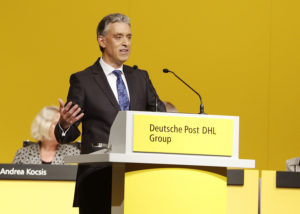Getting I.T. Right: What forwarders can learn from DHL’s struggle

No one ever said it would be easy. But few people thought it would be so hard.
DHL Global Forwarding, Freight, the logistics arm of Deutsche Post DHL, had finally determined that it was going to get rid of “Logis,” its legacy IT system that dated back as far as 30 years, patched together from the IT systems of several companies that had been acquired long ago.
Championed by Roger Crook, former CEO of DHL Global Forwarding (DHL-GF), a new system was billed as a key milestone in DHL’s modernization plan, called Strategy 2020. Plans for the new SAP-based enterprise software system, which would cover the length and breadth of the world’s largest forwarding operation, began as early as 2011. DHL even had a forward-thinking name chosen for the system: the “New Forwarding Environment,” or NFE, which was supposed to bring order to DHL’s globe-spanning operations, attract more business and add transparency to the process.
Less than four years and nearly US$1 billion later, the new system was scrapped. Kaput. DHL’s experience offers a cautionary I.T. tale for the air cargo industry, at large.
Phased-in rollout began in New Zealand in 2013, and the first signs of trouble came in 2014. By April 2015, the rollout was halted “temporarily” and Crook stepped down as division CEO. Saying the system just needed some extra tweaks, Deutsche Post DHL said it planned to rescue NFE, but in October 2015, CEO Frank Appel told investors that NFE would be dismantled and removed to make way for a new system – what kind, he did not elaborate. The company took a one-time hit of €345 million for pulling the plug in the third quarter of 2015.
So what happened? For now, DHL-GF won’t say. Air Cargo World asked DHL repeatedly for an interview on the subject, but spokespersons for the company said they preferred not to comment until a new IT system is announced later this year. Most other forwarders and IT experts contacted by ACW also declined to comment on the underlying causes, although a Stifel analysis predicted DHL-GF will “return to a more normal operating structure and use a mix of systems rather than rely solely on SAP.”
However, Ryan Petersen, CEO of U.S.-based forwarding and customs brokerage firm Flexport, said he has an idea about where DHL-GF went off the rails. After speaking with an un-named senior executive from DHL, he said the largest problem was improper change management. “Trying to get tens of thousands of people who are used to running in one direction to suddenly switch and run the other way – it’s a very difficult thing,” Petersen said.
“They haven’t really said why the system was cancelled,” said Chuck Schubert, president of logistics IT provider CSA Software, based in Livonia, Mich. “But it’s a common affliction in customized software deployment that happens more than people want to let on. One thing I can say is that designing software is an art, if not a science. It takes a lot of courage to pull the plug.”
Petersen said he does not envy DHL’s predicament. “I try not to criticize too harshly. I give them all the credit in the world for even trying something this ambitious,” he said. Rather that pointing fingers, Petersen suggested this should be a time to analyze the mistakes, share them with other forwarders and learn from the experience.
In describing the sheer effort involved in DHL-GF’s attempt, Petersen compared the NFE project with Elon Musk’s launching of the SpaceX rocket program – but with a twist. “Now imagine if Elon had to build that same rocket, only it had already taken off,” Petersen said. “It’s already flying and then you hear, ‘Well, we were going to the Moon, but now we’re going to Mars.’”
See sidebar on Panalpina’s SAP rollout




